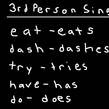Hello students!
Ya que hemos estudiado el Present Continuous, vamos a ver cómo se forman los verbos que llevan -ing. Ten en cuenta que estas reglas son también válidas para el Past Continuous.
1.- La regla general: se añade -ing al infinitivo del verbo sin to.
Ejemplo: to laugh -> laughing
2.- Verbos que terminan en -y: siguen la regla general.
Ejemplo: to buy -> buying
3.- Verbos que acaban en -e muda: se elimina la -e y se añade -ing.
Ejemplo: to dance -> dancing
4.- Verbos monosílabos consonante + vocal + consonante: doblan la última consonante y añaden -ing.
Ejemplo: to run -> running
5.-Verbos bisílabos que terminan en -l: doblan la -l y se añade -ing.
Ejemplo: to travel -> travelling
6.- Verbos bisílabos que tienen el acento en la última sílaba: doblan la última consonante y se añade -ing.
Ejemplo: to permit -> permitting
Vamos a practicar con algunos ejercicios:
Ejercicio 1. (by Eclectic English)




